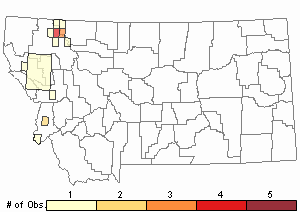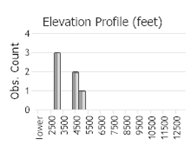View in other NatureServe Network Field Guides
NatureServe
Montana
Utah
Wyoming
Idaho
Wisconsin
British Columbia
South Carolina
Yukon
California
New York
Mougeot's Amphidium Moss - Amphidium mougeotii
General Description
Plants: Acrocarpous (Vitt 1988). Growing in deep green or, more frequently, ochre-colored tufts (Crum and Anderson et al. 1981) or crowded cushions. Stems upright with ascending branches, 20-50 mm in height (FNA 2014).
Leaves: Irregularly bent and spiraled when dry, expanding outwardly when wet, lance-shaped and linear, 1.5-3 mm in length; margins flat (FNA 2014), or occasionally turned back and under (Smith 1980), frequently somewhat toothed (Crum and Anderson et al. 1981) or, near the apex, wavy from papillae (Smith 1980); apex narrowly tipped (FNA 2014); costa reaching the tip or extending beyond it slightly (FNA 2014).
Leaf Cells: Proximal laminal cells with thickset walls, hyaline, rectangular; marginal laminal cells similar to the basal cells; cells above 6-sided and a little rounded (Smith 1980), partially concealed by tiny, lens-shaped papillae (FNA 2014) arranged in rows (“longitudinal striae”) (Crum and Anderson et al. 1981).
Diagnostic Characteristics
The papillae of A. mougeotii are tiny, elliptic, and only partially conceal the upper cells, whereas the papillae of A. lapponicum are “warty,” large and conspicuous. The laminal cells of A. lapponicum are larger as well (FNA 2014).
Range Comments
North American Range
Canada: Known in the northern territories, BC, Ontario and eastward; USA: in the Northwest, CA, CO, SD, MN, and most of the eastern states w to OH, KY, TN and AL (FNA 2014). Known in Montana from Flathead, Glacier, Lake, Meagher, and Ravalli Counties (Elliott 2016).
Observations in Montana Natural Heritage Program Database
Number of Observations: 18
(Click on the following maps and charts to see full sized version)
Map Help and Descriptions
Relative Density

Recency



 (Observations spanning multiple months or years are excluded from time charts)
(Observations spanning multiple months or years are excluded from time charts)
Habitat
Seasonally wet, seepy, shaded basic stones (Smith 1980), sandstone and granite, and in seepy, sheltered fissures of vertical faces, and close to waterfalls (Crum and Anderson et al. 1981). From low to high elevations (FNA 2014).
Reproductive Characteristics
Dioicous. Perichaetial leaves bigger than stem leaves, lengthened and slender, long-tipped; base enveloping the stem somewhat. Seta 2.2-3.5 mm in length. Capsule protruding beyond perichaetial leaves just slightly, 1-1.5 mm in length (FNA 2014), pleated when dry and old (Smith 1980), 8-ridged, contracted slightly under the mouth; peristome lacking (FNA 2014).
References
- Literature Cited AboveLegend:
 View Online Publication
View Online Publication Crum, H.A. and L.E. Anderson. 1981. Mosses of Eastern North America. 2 volumes. Columbia University Press, New York. 1328 pp.
Crum, H.A. and L.E. Anderson. 1981. Mosses of Eastern North America. 2 volumes. Columbia University Press, New York. 1328 pp. Elliott, J.C. and A.K. Pipp. 2018. A Checklist of Montana Mosses (1880-2018). Updated 3 January, 2020. Montana Natural Heritage Program, Helena, Montana. 73 pp.
Elliott, J.C. and A.K. Pipp. 2018. A Checklist of Montana Mosses (1880-2018). Updated 3 January, 2020. Montana Natural Heritage Program, Helena, Montana. 73 pp. Flora of North America Editorial Committee, eds. 2014. Flora of North America North of Mexico. Volume 28. Bryophytes: Mosses, Part 2. Oxford University Press, Inc., NY. xxi + 702 pp.
Flora of North America Editorial Committee, eds. 2014. Flora of North America North of Mexico. Volume 28. Bryophytes: Mosses, Part 2. Oxford University Press, Inc., NY. xxi + 702 pp. Smith, A.J.E. 1980. The Moss Flora of Britain and Ireland. Cambridge University Press, Cambridge. 705 pp.
Smith, A.J.E. 1980. The Moss Flora of Britain and Ireland. Cambridge University Press, Cambridge. 705 pp. Vitt, D. J. Marsh, and R. Bovey. 1988. Mosses, Lichens & Ferns of Northwest North America. Seattle, WA: University of Washington Press. 296 p.
Vitt, D. J. Marsh, and R. Bovey. 1988. Mosses, Lichens & Ferns of Northwest North America. Seattle, WA: University of Washington Press. 296 p.
- Additional ReferencesLegend:
 View Online Publication
View Online Publication
Do you know of a citation we're missing? Elliot, J. C. 1993. Second checklist of Montana mosses. Unpublished report. U.S. Forest Service, Region 1. Missoula, MT. 45 pp.
Elliot, J. C. 1993. Second checklist of Montana mosses. Unpublished report. U.S. Forest Service, Region 1. Missoula, MT. 45 pp. Lawton, E. 1971. Keys for the Identification of the Mosses on the Pacific Northwest. Reprinted from 'Moss Flora of the Pacific Northwest'. Published as Supplement No. 2 of the Journal of the Hattori Botanical Laboratory. Nichinan, Miyazaki, Japan. 66 pp.
Lawton, E. 1971. Keys for the Identification of the Mosses on the Pacific Northwest. Reprinted from 'Moss Flora of the Pacific Northwest'. Published as Supplement No. 2 of the Journal of the Hattori Botanical Laboratory. Nichinan, Miyazaki, Japan. 66 pp. Lawton, E. 1971. Moss Flora of the Pacific Northwest. Hattori Botanical Laboratory. Japan: Yamabuki-cho, Shinjuku-ku, Tokyo. 362 pages plus appendices.
Lawton, E. 1971. Moss Flora of the Pacific Northwest. Hattori Botanical Laboratory. Japan: Yamabuki-cho, Shinjuku-ku, Tokyo. 362 pages plus appendices.
- Web Search Engines for Articles on "Mougeot's Amphidium Moss"





